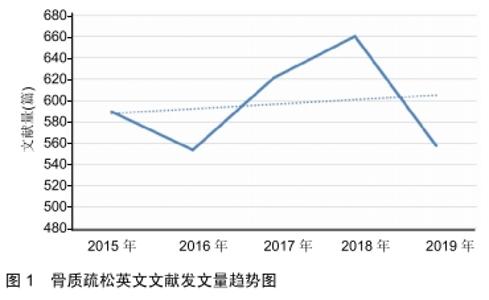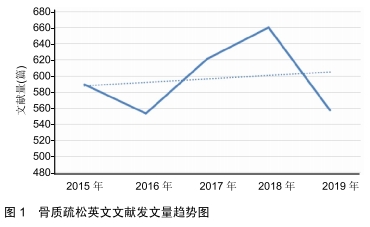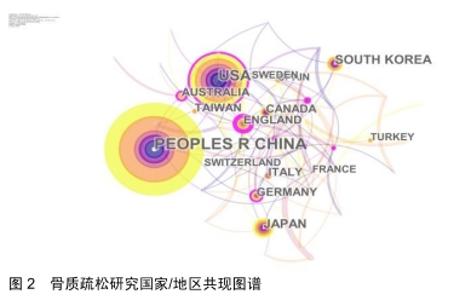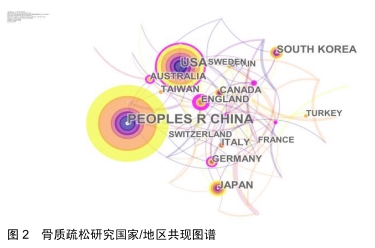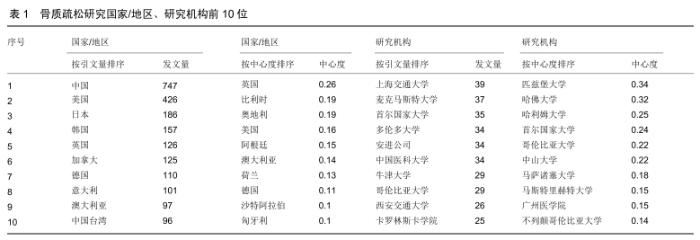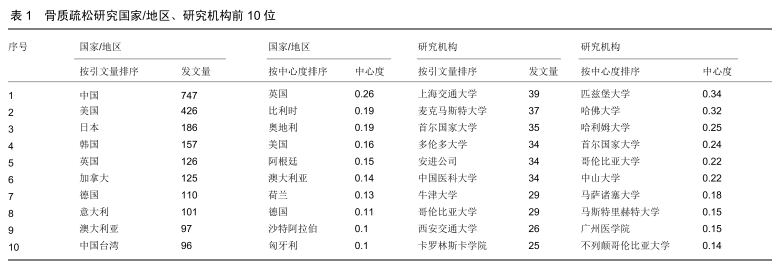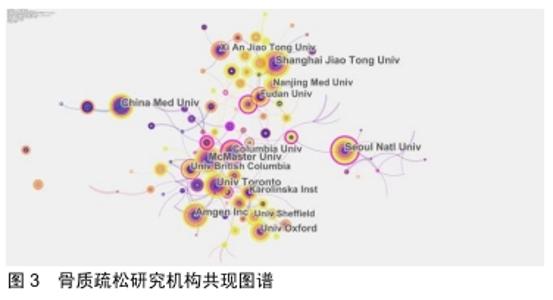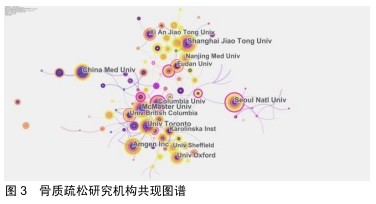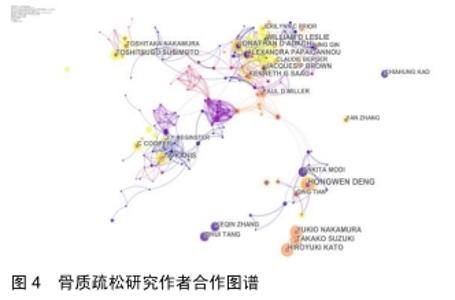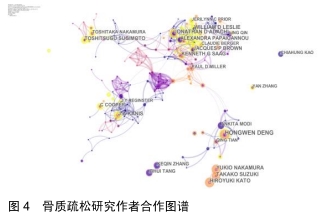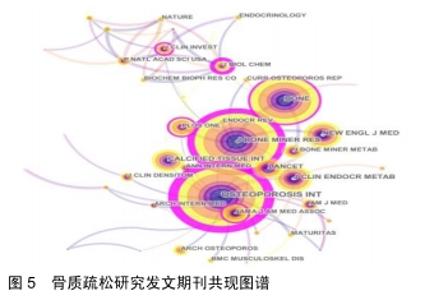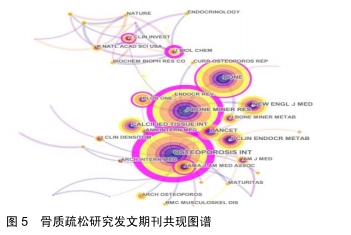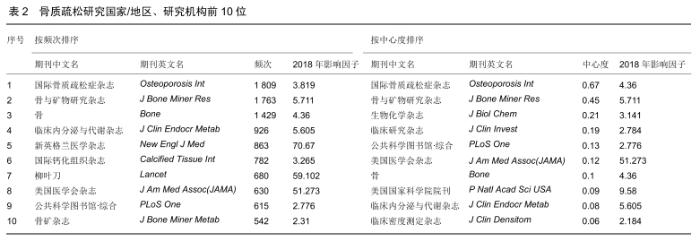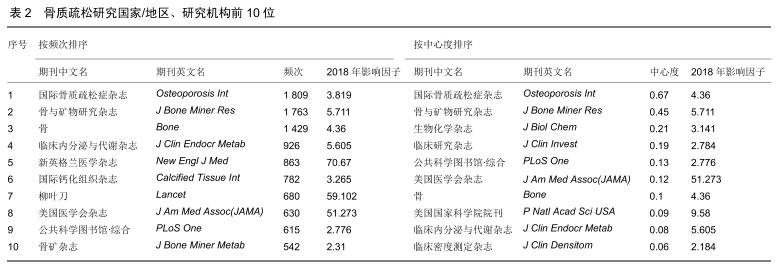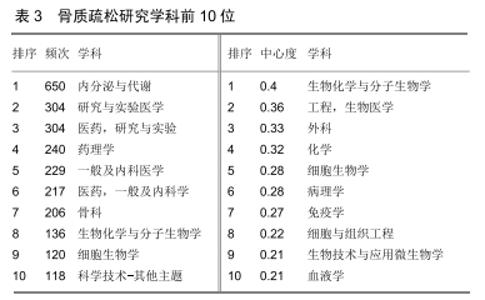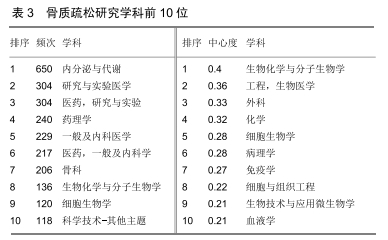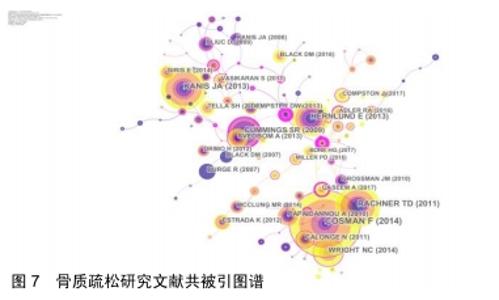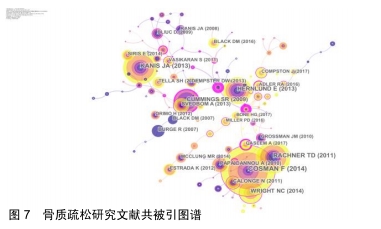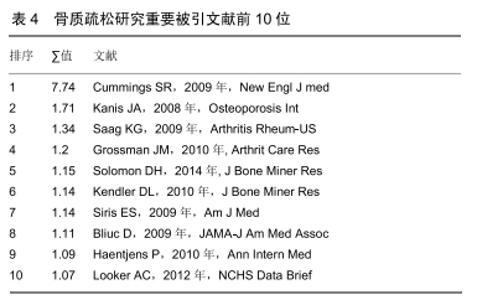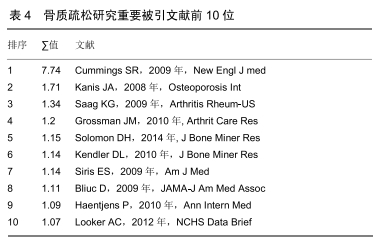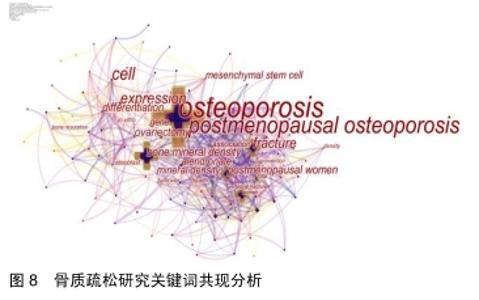Chinese Journal of Tissue Engineering Research ›› 2020, Vol. 24 ›› Issue (17): 2752-2758.doi: 10.3969/j.issn.2095-4344.2677
Previous Articles Next Articles
Metrology and visual analysis of English literature regarding osteoporosis in the past 5 years: based on the Web of Science
Zhang Qiang1, Zhu Chan1, 2
- 1Sichuan Provincial Orthopaedic Hospital, Chengdu 610041, Sichuan Province, China; 2Chengdu University of Traditional Chinese Medicine, Chengdu 610000, Sichuan Province, China
-
Received:2019-10-16Revised:2019-10-19Accepted:2019-12-04Online:2020-06-18Published:2020-03-30 -
About author:Zhang Qiang, Master, Attending physician, Sichuan Provincial Orthopaedic Hospital, Chengdu 610041, Sichuan Province, China -
Supported by:grants from Sichuan Provincial Orthopaedic Hospital, No. 2015-32 and 2015-04
CLC Number:
Cite this article
Zhang Qiang, Zhu Chan. Metrology and visual analysis of English literature regarding osteoporosis in the past 5 years: based on the Web of Science [J]. Chinese Journal of Tissue Engineering Research, 2020, 24(17): 2752-2758.
share this article
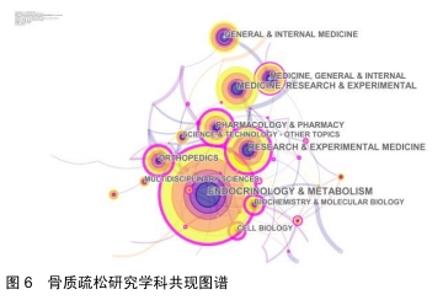
中心度排名最高的杂志是《国际骨质疏松症杂志》(0.67),第二个是《骨与矿物研究杂志》(0.45),第三是《生物化学杂志》(0.21),第四是《临床研究杂志》(0.19),第五是《公共科学图书馆·综合》(0.13),第六至十位详见表2。 2.6 学科 骨质疏松研究学科共现图谱见图6。频次最高的学科是内科学与代谢,频次数为650;第二是研究与实验医学,频次数为304;第三是医学,研究与实验,频次数为304;第四位是药物学与药典,频次数为240,第五至第十位详见表3。中心度排名最高的学科是生物化学与分子生物学,中心性为0.40;第二是工程,生物医学,中心度为0.36;第三是外科学,中心度为0.33,第四至十位详见表3。 "
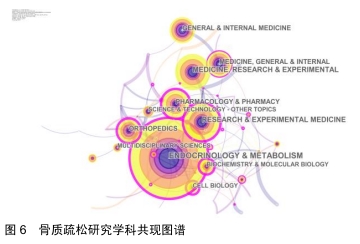

关键词分别以title、indexing term、abstract3种主题词分别得到关键词聚类:聚类结果是研究前沿领域[12,14],包括:缺乏引起的骨质疏松deficiency-induced osteoporosis、唑来膦酸zoledronic acid、糖皮质激素诱发的骨质疏松glucocorticoid-induced osteoporosis、脂肪量fat mass、卵巢切除术ovariectomy、唑来膦酸zoledronic acid、骨质疏松osteoporosis、矿物质密度mineral density、卵巢癌组Ovx group、抗骨质疏松药anti-osteoporosis drug、骨代谢bone metabolism,见图9。 "

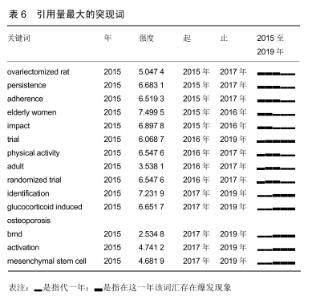
2.9 突现词(研究新兴领域) 突现(Burst detection)有突变、突发、剧增的意思,指一个变量的值在短期内有很大变化。通过突现词探测得到14个突现词,观察其时间变化可发现骨质疏松研究近5年可大致分为3个阶段:第1个阶段2015至2016年,去卵巢大鼠ovariectomized rat、坚持persistence、遵守adherence、老年妇女elderly women、影响impact;第2个阶段2016-2017年,试验trial、体力活动physical activity、成人adult、随机试验randomized trial;第3个阶段2017至2019年,鉴定identification、糖皮质激素诱导的骨质疏松glucocorticoid induced osteoporosis、骨密度bmd、激活activation、间充质干细胞mesenchymal stem cell,见表6。 "
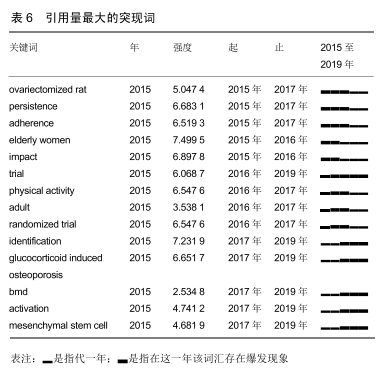
| [1] CHEN CM. CiteSpaceⅡ:Detecting and visualizing emerging trends and transient patterns in scientific literature.J Am Soc Inf Sci Tec. 2006;57(3):359-377. [2] LIU Z, YIN Y, LIU W, et al. Visualizing the intellectual structure and evolution of innovation systems research:a bibliometric analysis. Scientometrics.2015;103(1):135-158. [3] 崔德华,张惠敏,黄蓉,等.基于CiteSpace的中医体质学说知识图谱可视化分析[J].中华中医药杂志,2019,34(2):598-601. [4] 胡佳卉,孟庆刚.基于CiteSpace的中药治疗2型糖尿病知识图谱分析[J].中华中医药杂志,2017,32(9):4102-4106. [5] 莫明露,徐聪,段明香,等.基于CiteSpace Ⅲ的糖尿病行为干预研究可视化分析[J].中华疾病控制杂志,2016,20(8):825-830. [6] 戴阿咪,常青云,杜然然,等.基于CiteSpace的国内外精准医学研究热点与前沿分析[J].中华医学图书情报杂志, 2017,26(2):14-17. [7] 廖雅娴,何本祥,王纯,等.采用CiteSpace软件对肌腱病研究领域值得关注问题的可视化分析[J].中国组织工程研究, 2019,23(23):3746-3753. [8] 梁玉丹,王小寅,罗海丽,等.CiteSpace应用对Web of Science近5年针灸相关文献的计量学及可视化分析[J].中华中医药杂志, 2017,32(5): 2163-2168. [9] JULIET EC, MICHAEL RM, WILLIAM DL, et al. Osteoporosis. Lancet. 2019;393:364-376. [10] SVEDBOM A, HERNLUND E, IVERGÅRD M, et al. Osteoporosis in the European Union:a compendium of countryspecific reports.Arch Osteoporos.2013;8:137. [11] 刘光阳.CiteSpace国内应用的传播轨迹—基于2006—2015年跨库数据的统计与可视化分析[J].图书情报知识,2017(2):60-74. [12] 陈悦,陈超美,刘则渊,等.CiteSpace知识图谱的方法论功能[J].科学学研究, 2015,33(2):242-253. [13] 刘则渊.知识图谱的科学学源流[Z].第三期科学知识图谱与科学计量学方法与应用高级讲习班,2013:4. [14] 李杰.CiteSpace中文版指南[EB/OL]. http://blog.sciencenet.cn/blog-5541791066981.2015. [15] LIU YZ, ZHOU Y, ZHANG L, et al. Attenuated Monocyte Apoptosis, a New Mechanism for Osteoporosis Suggested by a Transcriptome- Wide Expression Study of Monocytes.PLoS One. 2015;10(2):1-18. [16] YANG TL, GUO Y, DENG HW, et al. Genome-wide Survey of Runs of Homozygosity Identifies Recessive Loci for Bone Mineral Density in Caucasian and Chinese Populations.J Bone Miner Res. 2015;30(11): 2119-2126. [17] TAN LJ, WANG ZE, DENG HW, et al. Bivariate Genome-Wide Association Study Implicates ATP6V1G1 as a Novel Pleiotropic Locus Underlying Osteoporosis and Age at Menarche.J Clin Endocr Metab. 2015;100(11):E1457-E1466. [18] NAKAMURA Y, SUZUKI T, KAMIMURA M, et al. Alfacalcidol Increases the Therapeutic Efficacy of Ibandronate on Bone Mineral Density in Japanese Women with Primary Osteoporosis.Tohoku J Exp Med. 2017;241(4):319-326. [19] SUZUKI T, NAKAMURA Y, KAMIMURA M, et al. Compliance and discontinuation of denosumab treatment in postmenopausal Japanese women with primary osteoporosis or rheumatoid arthritis and osteoporosis. Osteoporos Sarcopenia.2017;3(2):108-111. [20] SUZUKI T, NAKAMURA Y, KAMIMURA M, et al. Denosumab significantly improves lumbar spine bone mineral density more in treatment-naïve than in long-term bisphosphonate-treated patients. Bone Rep. 2018;8:110-114.. [21] ADACHI JD, BROWN JP, IOANNIDIS G. Characterizing the Assessment and Management of Vitamin D Levels in Patients with Osteoporosis in Clinical Practice: A Chart Review Initiative.J Osteoporos. 2015;2015:312952. [22] LONG YJ, LESLIE WD, LUO Y. Study of DXA-derived lateral–medial cortical bone thickness in assessing hip fracture risk.Bone Rep. 2015;2: 44-51. [23] KANIS JA.Osteoporotic fractures in Europe: are we doing enough.Ann Rheum Dis.2017:29-30. [24] KANIS JA. Osteoporosis:Who and when to treat.Osteoporosis Int. 2017;28:S43. [25] COSMAN F, DE BEUR SJ, LEBOFF MS, et al. Clinician's guide to prevention and treatment of osteoporosis.Osteoporosis Int. 2015;26(7): 2045-2047. [26] KANIS JA, MCCLOSKEY EV, JOHANSSON H, et al. European guidance for the diagnosis and management of osteoporosis in postmenopausal women.Osteoporosis Int.2013;24(1):23-57. [27] RACHNER TD, KHOSLA S, HOFBAUER LC. Osteoporosis: Now and the future(Article).Lancet.2011; 377(9773):1276-1287. [28] HERNLUND E, SVEDBOM A, IVERGÅRD M, et al. Osteoporosis in the European Union: medical management, epidemiology and economic burden. A report prepared in collaboration with the International Osteoporosis Foundation (IOF) and the European Federation of Pharmaceutical Industry Associations (EFPIA).Arch Osteoporos. 2013;8:136. [29] CUMMINGS SR, SAN MARTIN J, MCCLUNG MR, et al. Denosumab for prevention of fractures in postmenopausal women with osteoporosis(Article).New Engl J Med.2009;361(8):756-765. [30] ZHANG W ,ZHANG Q, YU B, et al. Knowledge map of creativity reseaech based on keywords network and co-word analysis, 1992-2011. Qual Quant.2015;49(3):1023-1035. [31] 陈悦,陈超美,刘则渊,等.CiteSpace知识图谱的方法论功能[J].科学学研究, 2015,33(2):242-253. [32] 邓亚军,解琪琪,李文洲,等.定量计算机断层扫描诊断骨质疏松症的相关文献可视化分析[J].中国医学物理学杂志, 2018,35(10):1139-1144. [33] 王庆学,李军,田兴中,等.基于GoPubMed的葛根与骨质疏松症研究文献计量分析[J].湖南中医杂志,2018,34(6):143-145. [34] 朱建明,林文弢,王兴.国内运动干预骨质疏松症研究脉络演进及前沿动态分析[J].广州体育学院学报,2017,37(6):92-96. [35] 邓亚军,解琪琪,李文洲,等.定量计算机断层扫描诊断骨质疏松症的相关文献可视化分析[J].中国医学物理学杂志, 2018,35(10):1139-1144. |
| [1] | Pu Rui, Chen Ziyang, Yuan Lingyan. Characteristics and effects of exosomes from different cell sources in cardioprotection [J]. Chinese Journal of Tissue Engineering Research, 2021, 25(在线): 1-. |
| [2] | Lin Qingfan, Xie Yixin, Chen Wanqing, Ye Zhenzhong, Chen Youfang. Human placenta-derived mesenchymal stem cell conditioned medium can upregulate BeWo cell viability and zonula occludens expression under hypoxia [J]. Chinese Journal of Tissue Engineering Research, 2021, 25(在线): 4970-4975. |
| [3] | Tang Hui, Yao Zhihao, Luo Daowen, Peng Shuanglin, Yang Shuanglin, Wang Lang, Xiao Jingang. High fat and high sugar diet combined with streptozotocin to establish a rat model of type 2 diabetic osteoporosis [J]. Chinese Journal of Tissue Engineering Research, 2021, 25(8): 1207-1211. |
| [4] | Li Zhongfeng, Chen Minghai, Fan Yinuo, Wei Qiushi, He Wei, Chen Zhenqiu. Mechanism of Yougui Yin for steroid-induced femoral head necrosis based on network pharmacology [J]. Chinese Journal of Tissue Engineering Research, 2021, 25(8): 1256-1263. |
| [5] | Wang Mengting, Gu Yanping, Ren Wenbo, Qin Qian, Bai Bingyi, Liao Yuanpeng. Research hotspots of blood flow restriction training for dyskinesia based on visualization analysis [J]. Chinese Journal of Tissue Engineering Research, 2021, 25(8): 1264-1269. |
| [6] | Luo Lin, Song Naiqing, Huang Jin, Zou Xiaodong. Review and prospect of international research on preschool children’s movement development assessment: a CiteSpace-based visual analysis [J]. Chinese Journal of Tissue Engineering Research, 2021, 25(8): 1270-1276. |
| [7] | Wang Xianyao, Guan Yalin, Liu Zhongshan. Strategies for improving the therapeutic efficacy of mesenchymal stem cells in the treatment of nonhealing wounds [J]. Chinese Journal of Tissue Engineering Research, 2021, 25(7): 1081-1087. |
| [8] | Wang Shiqi, Zhang Jinsheng. Effects of Chinese medicine on proliferation, differentiation and aging of bone marrow mesenchymal stem cells regulating ischemia-hypoxia microenvironment [J]. Chinese Journal of Tissue Engineering Research, 2021, 25(7): 1129-1134. |
| [9] | Kong Desheng, He Jingjing, Feng Baofeng, Guo Ruiyun, Asiamah Ernest Amponsah, Lü Fei, Zhang Shuhan, Zhang Xiaolin, Ma Jun, Cui Huixian. Efficacy of mesenchymal stem cells in the spinal cord injury of large animal models: a meta-analysis [J]. Chinese Journal of Tissue Engineering Research, 2021, 25(7): 1142-1148. |
| [10] | Hou Jingying, Yu Menglei, Guo Tianzhu, Long Huibao, Wu Hao. Hypoxia preconditioning promotes bone marrow mesenchymal stem cells survival and vascularization through the activation of HIF-1α/MALAT1/VEGFA pathway [J]. Chinese Journal of Tissue Engineering Research, 2021, 25(7): 985-990. |
| [11] | Shi Yangyang, Qin Yingfei, Wu Fuling, He Xiao, Zhang Xuejing. Pretreatment of placental mesenchymal stem cells to prevent bronchiolitis in mice [J]. Chinese Journal of Tissue Engineering Research, 2021, 25(7): 991-995. |
| [12] | Liang Xueqi, Guo Lijiao, Chen Hejie, Wu Jie, Sun Yaqi, Xing Zhikun, Zou Hailiang, Chen Xueling, Wu Xiangwei. Alveolar echinococcosis protoscolices inhibits the differentiation of bone marrow mesenchymal stem cells into fibroblasts [J]. Chinese Journal of Tissue Engineering Research, 2021, 25(7): 996-1001. |
| [13] | Fan Quanbao, Luo Huina, Wang Bingyun, Chen Shengfeng, Cui Lianxu, Jiang Wenkang, Zhao Mingming, Wang Jingjing, Luo Dongzhang, Chen Zhisheng, Bai Yinshan, Liu Canying, Zhang Hui. Biological characteristics of canine adipose-derived mesenchymal stem cells cultured in hypoxia [J]. Chinese Journal of Tissue Engineering Research, 2021, 25(7): 1002-1007. |
| [14] | Geng Yao, Yin Zhiliang, Li Xingping, Xiao Dongqin, Hou Weiguang. Role of hsa-miRNA-223-3p in regulating osteogenic differentiation of human bone marrow mesenchymal stem cells [J]. Chinese Journal of Tissue Engineering Research, 2021, 25(7): 1008-1013. |
| [15] | Lun Zhigang, Jin Jing, Wang Tianyan, Li Aimin. Effect of peroxiredoxin 6 on proliferation and differentiation of bone marrow mesenchymal stem cells into neural lineage in vitro [J]. Chinese Journal of Tissue Engineering Research, 2021, 25(7): 1014-1018. |
| Viewed | ||||||
|
Full text |
|
|||||
|
Abstract |
|
|||||
